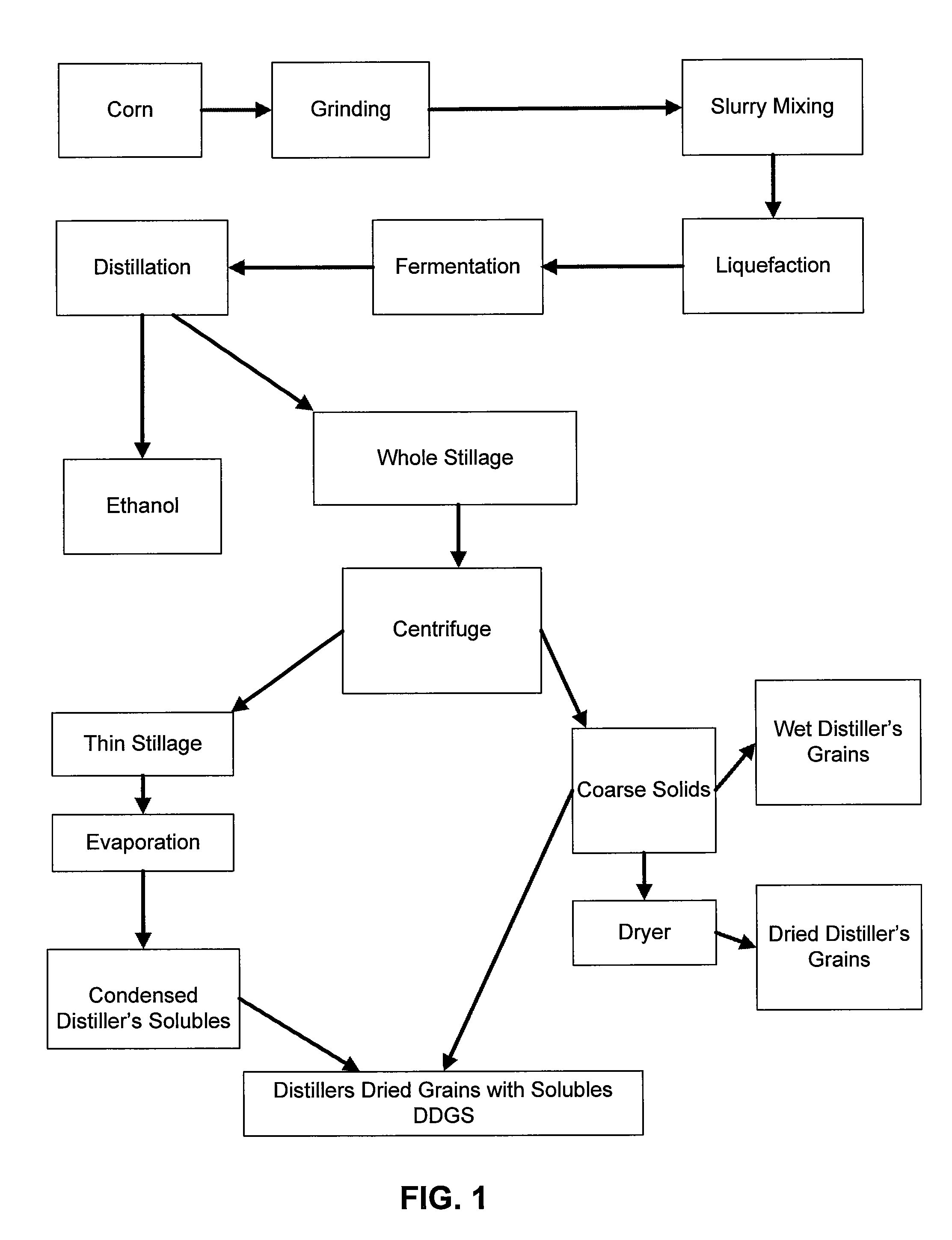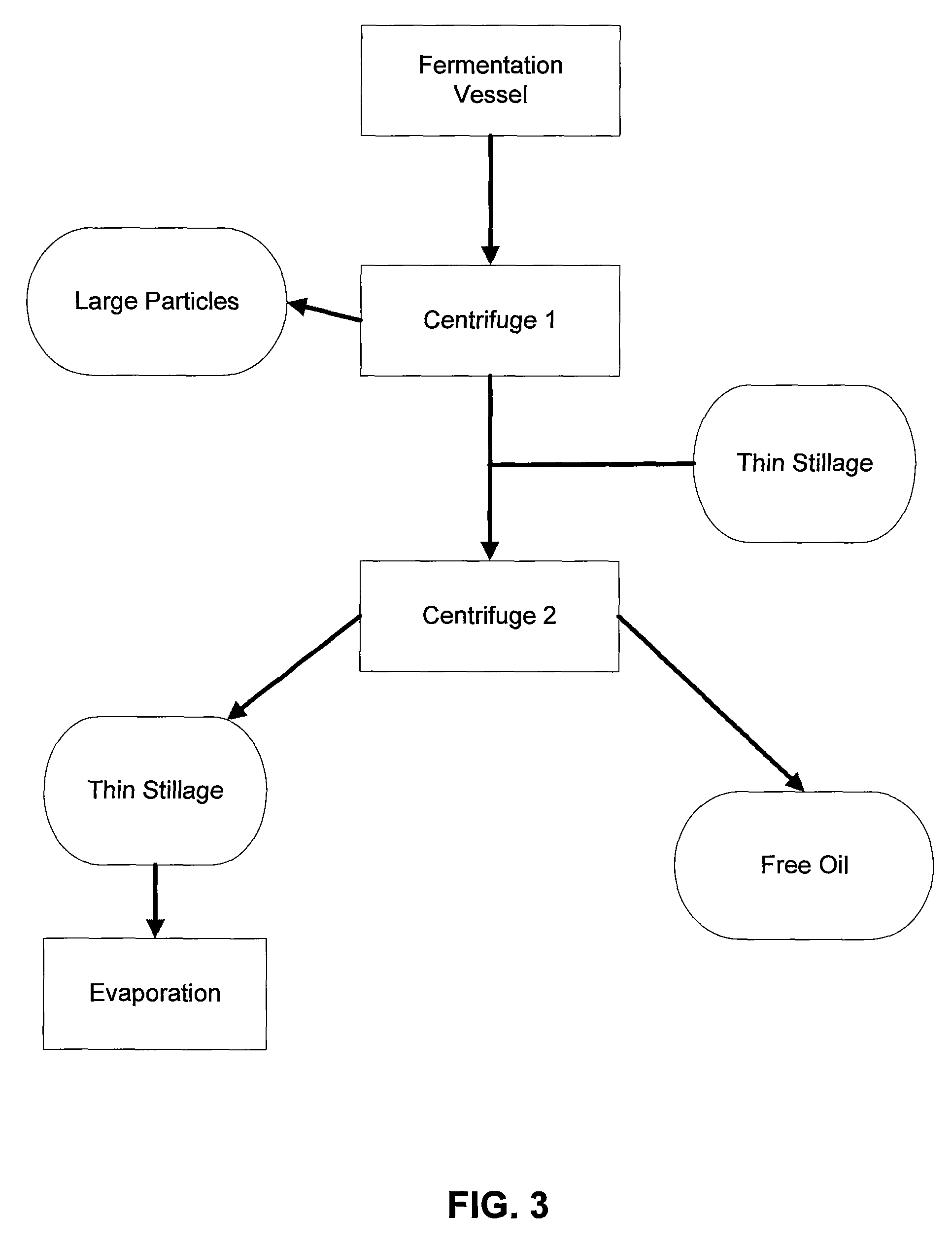Method of liberating bound oil present in stillage
a stillage and bound oil technology, applied in the direction of fatty oil/acid recovery from waste, fatty substance recovery, fatty substance production, etc., to achieve the effect of reducing or extracting the oil content, improving efficiency and yield, and facilitating the recovery of crude oil
- Summary
- Abstract
- Description
- Claims
- Application Information
AI Technical Summary
Benefits of technology
Problems solved by technology
Method used
Image
Examples
example 1
[0035]A sample of condensed corn distillers solubles was obtained from a commercial ethanol production plant. The sample was diluted with water to return it to ‘thin stillage’ containing approximately 15% total solids. The thin stillage was centrifuged (3,200×g) to remove insolubles. The supernatant, including all the oils and gums, was decanted for use as a fermentation media. The media pH was adjusted to 7.6 with potassium hydroxide. An inoculant consisting of lactobacillus plantarum, obtained from Medipharm USA (Des Moines, Iowa), was made by re-hydrating 10 g of dried microbial culture containing 1×108 cfu per gram in 100 ml warm water. Duplicate samples of media (100 g) were inoculated with 5 ml of the re-hydrated culture and incubated anaerobically for 0, 12, 24, 36, or 48 hours. At the end of each fermentation period, the gums and oils were separated from the total media by using a separatory funnel. The gums and oils were centrifuged (Drucker 614B) at 1,200×g to separate the...
example 2
[0036]A sample of thin stillage was obtained from a commercial ethanol production plant. The sample was pH adjusted to 7.0 and used as a fermentation media without further processing. An inoculant comprising a mixture of Lactobacillus plantarum, L. casei and L. acidophilus, obtained from Medipharm USA (Des Moines, Iowa), was made by rehydrating 3 g of each dried microbial culture containing 1×108 cfu per gram in 100 ml of warm water. Triplicate sample of thin stillage media (100 g) were inoculated with 5 ml of the rehydrated culture and incubated anaerobically at ambient temperature (20° C.) for 0, 12, 24, 36 or 48 hours. At the end of each fermentation period, the gums and oils were separated from the total media by using a separatory funnel. The gums and oils were centrifuged (Drucker 614B) at 1,200×g to separate the crude oil from any remaining gums. The oil was decanted and weighed. The gums were filtered (Whatman 54, 20-25 microns) with filter paper, rinsed, dried and weighed. ...
example 3
[0037]A sample of thin stillage was obtained from a commercial ethanol plant. The stillage was further centrifuged to remove small insoluble materials and the supernatant along with all the gums and oils was collected and used as a fermentation media. The media was pH adjusted to 7.5 using KOH and divided into triplicate Erlenmeyer flasks (1000 g media). An inoculant consisting of lactobacillus plantarum, obtained from Medipharm USA (Des Moines, Iowa), was made by rehydrating 10 g of dried microbial culture containing 1×108 cfu per gram in 100 ml warm water. Ten milliliters of inoculum was transferred into each flask before sealing them tightly and placing into an incubator-shaker set at 60° C. for 48 hours. At the end of each fermentation period, the gums and oils were separated from the total media by using a separatory funnel. The gums and oils were centrifuged at 3,000×g to separate the crude oil from any remaining gums. The oil was decanted and weighed. A sample of stillage bef...
PUM
| Property | Measurement | Unit |
|---|---|---|
| temperature | aaaaa | aaaaa |
| temperature | aaaaa | aaaaa |
| temperature | aaaaa | aaaaa |
Abstract
Description
Claims
Application Information
 Login to View More
Login to View More - R&D
- Intellectual Property
- Life Sciences
- Materials
- Tech Scout
- Unparalleled Data Quality
- Higher Quality Content
- 60% Fewer Hallucinations
Browse by: Latest US Patents, China's latest patents, Technical Efficacy Thesaurus, Application Domain, Technology Topic, Popular Technical Reports.
© 2025 PatSnap. All rights reserved.Legal|Privacy policy|Modern Slavery Act Transparency Statement|Sitemap|About US| Contact US: help@patsnap.com



